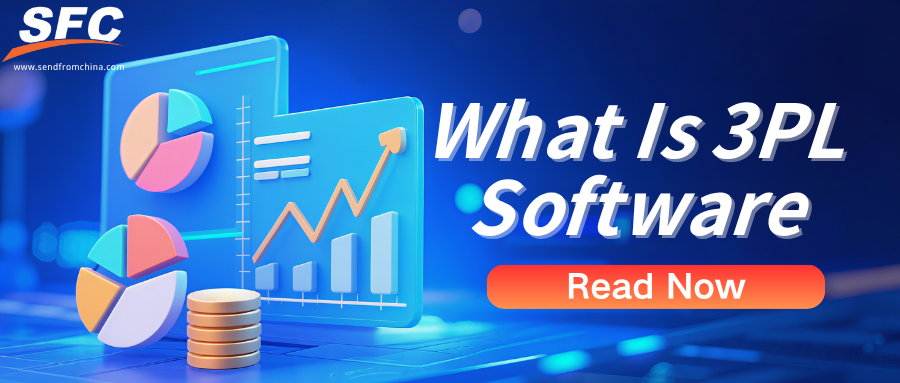Table of Contents
What Is 3PL Software? The Definition, Advantages and How to Select
Time: Jun 24,2025 Author: SFC Source: www.sendfromchina.com
Supply chain demands are changing at lightning speed, and 3PL providers who lean on 3PL software are thriving. This integrated toolkit blends WMS, TMS, OMS, billing, and analytics to deliver end-to-end logistics mastery. Read on to discover what it is, why it matters, how it works in real life, and what to watch out for when choosing the best fit.
1. What Is 3PL?
Third‑party logistics (3PL) refers to outsourcing some or all logistics functions—such as warehousing, inventory management, order fulfillment, and transportation—to an external provider. It’s a strategic partnership: you produce or procure goods, ship them in bulk to a 3PL’s fulfillment centers, and they handle storage, picking, packing, shipping, and returns.3PLs range in scope. Basic providers focus on core functions like warehousing and freight forwarding, known as “standard 3PLs.” Others are service developers offering enhanced features such as tracking, custom packaging, and compliance services. They differ from 2PLs (transport-only) and 4PLs, which manage your whole logistics network, including multiple 3PLs.
2. What Is 3PL Software?
3PL software, also known as third‑party logistics software, is a specialized suite of tools designed to streamline and automate logistics workflows for providers managing multiple clients. Beyond basic warehouse management, it integrates order routing, transportation management, billing, reporting, and real‑time inventory visibility.
- WMS (Warehouse Management System): Optimizes inventory placement, picking, packing, and inventory control.
- TMS (Transportation Management System): Manages carrier selection, route planning, freight audit, and tracking.
- OMS (Order Management System): Orchestrates orders from placement to fulfillment.
- ERP/SCM (Enterprise/Supply‑Chain Management): Integrates financials, workforce, and procurement with logistics operations.
Today’s 3PL software enables multi‑client handling, SLA‑based billing, customizable workflows, integration with e‑commerce and CRM platforms, and visibility across the entire supply chain.
3. What Are the Advantages of 3PL Software?
In an increasingly complex and fast-moving supply chain environment, the need for agility, transparency, and operational efficiency has never been greater. This is where 3PL software proves indispensable. By unifying disparate logistics tasks—across warehousing, transportation, inventory, billing, and tracking—into one streamlined ecosystem, it delivers benefits that are both immediate and long-term. Here’s a deeper look at the multi-faceted advantages of adopting 3PL software:
3.1 Operational Efficiency Through Automation
At its core, 3PL software automates repetitive and manual tasks that would otherwise consume hours of labor and invite human error. Order routing, shipment scheduling, labeling, inventory updates, and invoicing are all automated, freeing staff to focus on higher-value tasks. Automation also ensures speed and consistency—especially during peak periods when manual systems tend to buckle under pressure.Example: Instead of manually checking stock and printing shipping labels for each order, the software pulls real-time inventory data, suggests optimal pick paths, and auto-generates compliant labels within seconds.
3.2 Real-Time Visibility Across the Supply Chain
3PL software enables end-to-end visibility for warehouse operators, clients, and even end-customers. From inbound shipments to last-mile delivery and returns, every movement is traceable in real time. This visibility empowers decision-makers to take corrective actions quickly—whether it’s re-routing a delayed shipment or reallocating inventory across warehouses.Benefit: With accurate dashboards and alerts, you avoid stockouts, delays, and miscommunication—leading to smoother operations and higher customer satisfaction.
3.3 Scalability Without Disruption
Whether you’re onboarding new clients, expanding to additional warehouses, or dealing with seasonal spikes, 3PL software scales with you. Unlike legacy systems that may require reconfiguration or downtime, modern cloud-based platforms offer elastic scaling. You can handle 10 or 10,000 SKUs, process hundreds or millions of orders, all without sacrificing performance.Insight: For growing 3PLs, the ability to scale quickly—without hiring more staff or overhauling systems—is a critical competitive edge.
3.4 Enhanced Inventory Accuracy
Inventory accuracy is the linchpin of effective logistics. Even a 2% discrepancy can lead to lost sales or overstocking. 3PL software maintains precise stock counts by syncing real-time data from barcode scans, RFID systems, and API-integrated channels. It also supports cycle counting and automatic reconciliation, reducing the need for full physical audits.Result: Inventory accuracy rates often climb above 99% when a robust 3PL system is in place.
3.5 Customization for Multi-Client Management
A major strength of 3PL software lies in its ability to support multiple clients within the same infrastructure. Each client can have customized workflows, billing rules, storage policies, and user access levels. This segmentation ensures that service-level agreements (SLAs) are honored on a per-client basis, with clear audit trails and account-specific reporting.Flexibility: Whether one client uses FIFO and another prefers LIFO, or one needs daily reporting while another requires weekly dashboards—the system adapts without compromising performance.
3.6 Streamlined Billing and SLA Enforcement
Traditional billing in logistics often involves a maze of spreadsheets and manual calculations—making it prone to errors and delays. 3PL software automates billing based on predefined rules: storage duration, per-pick charges, freight costs, handling surcharges, and SLA penalties. These automated invoices are accurate, transparent, and often integrated with accounting platforms.Impact: Faster billing cycles, fewer disputes, and improved cash flow for 3PL providers.
3.7 Data-Driven Decision-Making
The modern supply chain is data-rich, but not every company can harness that data effectively. 3PL software provides built-in analytics and reporting tools to track warehouse throughput, carrier performance, pick-and-pack accuracy, labor utilization, order cycle times, and more. These insights enable managers to identify inefficiencies, monitor KPIs, and plan proactively.Real World Example: A 3PL using software analytics may discover that orders shipped via Carrier A have a 12% higher on-time delivery rate than Carrier B—leading to strategic adjustments that reduce delays.
3.8 Improved Customer Service
Today’s logistics clients demand transparency, accuracy, and speed—and 3PL software delivers on all three. Clients can access self-service portals to view order statuses, stock levels, billing reports, and exception notifications. This reduces the back-and-forth communication traditionally required and increases client trust and retention.Plus: End-customers benefit from live tracking, faster delivery estimates, and fewer order issues, enhancing the entire customer experience.
3.9 Compliance and Documentation
Logistics is subject to stringent compliance regulations—customs declarations, FDA rules, hazmat handling, import/export documentation, and more. 3PL software helps automate and standardize documentation, flagging incomplete records or non-compliant shipments before they become legal or operational issues.Advantage: This is especially critical for 3PLs handling cross-border or industry-regulated goods (like food, pharma, or electronics).
3.10 Reduced Human Error and Labor Dependency
By minimizing manual data entry and standardizing workflows, 3PL software significantly lowers the risk of human error—from missed orders to shipping mistakes. It also reduces dependency on specific individuals with “tribal knowledge,” allowing new staff to onboard faster using system-guided processes.Operational Resilience: In industries with high turnover or seasonal staff, this can make or break continuity.
3.11 Better Collaboration Across the Ecosystem
Logistics is inherently collaborative—3PLs must coordinate with suppliers, carriers, customs agencies, and clients. A centralized platform ensures that all stakeholders work from the same data set. Through APIs, EDI, and client portals, 3PL software enhances communication, speeds issue resolution, and reduces information silos.Outcome: Greater collaboration leads to a more responsive, agile, and integrated supply chain.
4. How Does 3PL Software Work in Practice?
To truly understand the power of 3PL software, you need to see it in action. At its essence, 3PL software serves as the digital backbone of logistics operations—coordinating data, people, inventory, and transportation in real time. It doesn't just store information; it orchestrates entire workflows with precision and scalability.
Step 1: Receiving and Inbound Inventory Management
When a shipment from a manufacturer or supplier arrives at the warehouse, the process begins with receiving. Staff scan inbound pallets or cartons using mobile devices or RFID scanners. The system records the quantity, SKU information, and expected storage requirements.The Warehouse Management System component of the 3PL software:
- Matches the shipment against advanced shipping notices (ASNs)
- Flags any discrepancies or damage
- Automatically suggests optimal bin or shelf placement based on turnover rate and space utilization
Smart Functionality Example: Frequently ordered items may be directed to forward picking zones for faster access, while slow-moving stock is assigned to higher or back-tier shelving.
Step 2: Inventory Management and Visibility
Once inventory is stored, it’s tracked continuously within the system. Every movement—whether it’s a relocation, count adjustment, or pick—is recorded in real-time. Clients can log into their customer portal to see exact inventory levels, location, and shelf life, eliminating guesswork.- Real-time stock levels prevent overselling
- FIFO/LIFO rules are enforced automatically
- Expiry tracking is enabled for perishable goods
Outcome: This drastically reduces write-offs, backorders, and customer complaints.
Step 3: Order Management and Fulfillment Orchestration
When a customer order is received—either manually entered or through integrations with Shopify, Amazon, WooCommerce, or ERP systems—the Order Management System (OMS) kicks in.It:
- Validates product availability and client rules
- Assigns the order to the optimal warehouse (if multi-site)
- Creates picking tasks based on priority, order size, or shipping method
Scenario: A client’s Amazon Prime order arrives at 4 PM with a guaranteed next-day delivery. The system flags it as high priority and dynamically adjusts the pick/pack queue.
Step 4: Picking and Packing
The WMS generates digital pick lists for warehouse staff—often sent to handheld devices or wearable scanners. Advanced systems can group orders to optimize travel time (batch picking or wave picking).After picking:
- Items are scanned again at packing stations to verify accuracy
- The system suggests box sizes based on item dimensions
- Packing slips, shipping labels, and customs documents are auto-generated
Smart Tip: Some systems even integrate AI to suggest void fill materials or calculate dimensional weight to minimize shipping costs.
Step 5: Shipping and Carrier Management
With the package ready, the Transportation Management System (TMS) component takes over.Key functions include:
- Carrier rate shopping in real time (FedEx, UPS, DHL, regional carriers)
- Carrier assignment based on cost, SLA, or customer preference
- Automatic scheduling of pickups or drop-off notifications
- Label and manifest generation in compliance with carrier specs
Example: If Carrier A is delayed due to weather, the system can automatically switch to Carrier B with similar service levels.
Step 6: Tracking and Notifications
After dispatch, tracking numbers are pushed to clients and customers through API, email, or SMS. Status updates—out for delivery, delivered, delayed—are pulled from carriers and shown in the client dashboard.This ensures:
- Proactive exception management
- Fewer WISMO (“Where Is My Order?”) calls
- Better SLA compliance tracking
Benefit: Clients can even trigger workflows based on delivery status—such as post-delivery surveys or return label generation.
Step 7: Returns and Reverse Logistics
In the event of a return, 3PL software handles the Return Merchandise Authorization (RMA) process. Customers initiate returns via client systems or branded portals, and the return is tracked from arrival to final disposition.Warehouse staff inspect returned goods, and based on condition, the software routes items to:
- Inventory for restock
- Refurbishment
- Disposal or quarantine
Insight: Well-integrated returns workflows can reduce refund cycle times by up to 40%.
Step 8: Client-Specific Billing and Invoicing
Behind the scenes, the billing engine tracks every billable activity—storage by cubic feet, pick fees, packing labor, shipping charges, labeling, and even late fees. These are compiled into client-specific invoices with itemized breakdowns.Billing can be:
- Monthly, weekly, or per-transaction
- Triggered automatically upon service completion
- Integrated with QuickBooks, NetSuite, or custom ERP systems
Compliance Assurance: Automated billing reduces disputes and ensures alignment with client contracts.
Step 9: Analytics and Performance Dashboards
Finally, every event, timestamp, and transaction feeds into a centralized analytics dashboard. Managers and clients can view:- Daily order volumes
- Order accuracy rates
- Pick/pack speeds
- Inventory turnover
- Carrier performance metrics
Example Use: A 3PL operator sees that 40% of SLA breaches are tied to a specific pick zone—leading to layout adjustments that improve throughput.
5. How to Select the Right 3PL Software?
Choosing the right 3PL software is more than just a software-buying exercise—it’s a strategic decision that can transform your logistics operations. From boosting efficiency to safeguarding scalability, the right system aligns with both current needs and future goals. Here’s how to approach the selection process in a methodical, evidence-driven manner:
Conduct a Thorough Self-Audit
Start by mapping your current logistics and fulfillment workflows. Document:- Volume of orders (daily, weekly, peak seasons)
- Number of SKUs and product complexity
- Channel integrations (e-commerce platforms like Shopify, ERP systems, marketplace connections)
- Pain points (e.g., stockouts, mispicks, delayed billing)
Define Core Functional Requirements
Once your audit is complete, specify must-have features. The essentials include:- Multi-client handling: True 3PL systems support siloed inventories, workflows, and billing for each client.
- Built-in WMS, TMS, and OMS: These core modules manage warehousing, transportation, and orders—all under one roof.
- Billing & SLA automation: Billing based on agreed terms (storage, pick/pack, surcharges, SLA penalties) should be accurate and auditable.
- Real-time visibility: Accurate, live data for inventory, orders, shipments, and returns is non-negotiable.
Evaluate System Architecture & Scalability
Cloud-native, SaaS-based platforms are ideal for their on-demand scale and ease of deployment. Verify:- Elastic capacity to handle seasonal surges without downtime or manual reconfigurations.
- Transparent pricing models that don’t levy hidden fees for users, orders, or integrations.
Integration & API Capabilities
A 3PL system must seamlessly communicate with your existing stack. Look for:- Prebuilt connectors for major e‑commerce platforms, ERPs, and accounting tools.
- Robust API support to enable future integrations or custom workflows without vendor lock-in.
User Experience & Implementation
Usability is often overlooked, yet vital. Opt for systems with:- Intuitive UI/UX to minimize training time and reduce errors.
- Phased implementation options, such as pilot rollouts or sandbox environments, to test workflows before full deployment.
Vendor Credibility & Support
Strong vendor support can make or break a rollout. Evaluate:- Client references, case studies, and industry recognition to validate reliability.
- SLAs, response times, and account management structure—especially during go-live.
Reporting, Analytics & Continuous Improvement
Your 3PL software should include or support:- Dashboards for KPIs like order accuracy, dwell time, pick/pack rates, carrier performance.
- Support for predictive analytics or AI for demand forecasting, intelligent routing, and labor planning.
Compliance, Security & Resilience
Logistics is tightly regulated, so verify:- Certifications like SOC 2, ISO 27001—especially if handling sensitive or hazardous goods.
- Features like role-based access control, encryption, and audit logs.
- Contingency planning for disaster recovery and business continuity.
Total Cost of Ownership (TCO) & ROI
A low license fee isn’t enough. Factor in:- Setup costs, integrations, training, and any hardware requirements
- Transactional or usage fees (per order, user)
- Exit fees or data migration costs when switching vendors.
Project ROI based on labor savings, fewer stock inaccuracies, improved SLA compliance, and billing efficiency. Many 3PLs see ROI in under 12 months.
Plan for Future Needs
Your ideal system today may fall short tomorrow. Consider:- How the platform supports emerging features like temperature monitoring, robotics, IoT sensors, or carbon tracking.
- Vendor roadmap and investment in innovation.
6. Red Flags When Evaluating 3PL Software Vendors
When assessing 3PL software options, beware of these warning signs:- Hidden Costs: Watch for charges on integrations, users, transactions, and exit penalties.
- Poor Multi‑Client Support: Systems without true siloing or client‑based billing are risky.
- Weak Integration Options: Limited API or no prebuilt connectors to major platforms is a deal breaker.
- Low Vendor Experience: Beware startups with no live deployments or poor references.
- Overpromising, Underdelivering: If demos seem smooth but no strong case studies exist, it may lack real-world robustness.
- Rigid Systems: Custom‑coded or legacy platforms hinder flexibility and can’t adapt to business changes.
- Shaky Support: Poor onboarding, slow tickets, or lack of local/regional coverage can derail operations.
7. Conclusion
3PL software is the backbone of modern outsourced logistics, combining WMS, TMS, OMS, billing, and analytics into seamless, scalable platforms. Properly chosen and implemented, it drives efficiency, accuracy, visibility, and client satisfaction. Selecting the right system requires holistic planning—assessing current needs, future growth, integrations, costs, and vendor fit. Stay alert to red flags—hidden fees, weak multi-client support, limited flexibility. With the right partner and platform, your logistics operations will scale profitably and reliably, empowering you to focus on what you do best.8. FAQs
Q1: What’s the difference between WMS and 3PL software?
A: WMS focuses just on warehouse operations. 3PL software is an integrated suite (WMS+TMS+OMS) built for managing multisided client operations, billing, routing, and reporting.Q2: Can small 3PLs use this software?
A: Absolutely. There are scalable SaaS solutions tailored for smaller teams. Startups can begin with core WMS/TMS functionality and upgrade as they grow.Q3: How long does implementation usually take?
A: Timeline varies, but most implementations range from 3 to 6 months. More complex integrations extend that.Q4: Will it integrate with my e-commerce platform?
A: Yes—modern systems offer prebuilt integrations with ERPs, Shopify, Amazon, WooCommerce, etc. Always verify availability of specific connectors.Q5: What’s the ROI on 3PL software?
A: ROI shows up through labor reduction, order‑error savings, better space utilization, lower shipping costs, and happier clients. Many providers see payback within the first 6–12 months. Post Views:891
Post Views:891
Copyright statement: The copyright of this article belongs to the original author. Please indicate the source for reprinting.
Previous Post
What Is Discreet Shipping? A Complete Guide for Online Shoppers & Retailers
Next Post
What Is Stocktake? A Step-by-Step Guide to Warehouse Inventory Counting
TAGS
Hot Research
Recent News
Get a Custom China Fulfillment Solution with FREE Storage for 30 Days
 Want to know about our services, fees or receive a custom quote?
Want to know about our services, fees or receive a custom quote?
 Please fill out the form on the right and we will get back to you within a business day.
Please fill out the form on the right and we will get back to you within a business day.
 The more information you provide, the better our initial response
will be.
The more information you provide, the better our initial response
will be.





 TAGS:
TAGS: